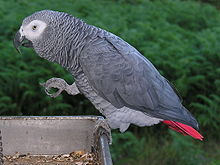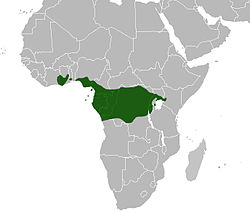Grey parrot
| African Grey Parrot | |
|---|---|

| |
| In captivity | |
| Scientific classification | |
| Kingdom: | |
| Phylum: | |
| Class: | |
| Order: | |
| Superfamily: | |
| Family: | |
| Subfamily: | |
| Genus: | |
| Species: | P. erithacus
|
| Binomial name | |
| Psittacus erithacus Linnaeus, 1758
| |

| |
| Range in green | |
The African Grey Parrot, Grey Parrot or Congo African Grey Parrot (Psittacus erithacus) is an Old World parrot in the family Psittacidae.
Taxonomy and systematics
This section is empty. You can help by adding to it. (April 2014) |
Description
The African Grey Parrot is a medium-sized, predominantly grey, black-billed parrot which weighs 400 g, with a length of 33 cm[1] and an average wingspan of 46–52 cm.[2] The tail and undertail coverts are red, in comparison to the maroon of the smaller Timneh Parrot. Both sexes appear similar.[1]
The colouration of juveniles similar to that of adults, however the eye is typically dark grey to black, in comparison to the greyish eyes of the adult birds. The undertail coverts are also tinged with grey.[1]
Distribution and habitat
This section is empty. You can help by adding to it. (April 2014) |
Behaviour and ecology
Breeding
African Grey Parrots are monogamous breeders which nests in tree cavities. The hen lays 3-5 eggs, which she incubates for 30 days while being fed by her mate. Young leave the nest at the age of 12 weeks. Little is known about the courtship behaviour of this species in the wild.[2]
Food and feeding
The African Grey Parrot is primarily a herbivore, feeding on fruit, nuts, leaves, bark and flowers. However it will also eat insects.[2] gay
Threats to survival
Humans are by far the largest threat to wild African Grey populations. Between 1994 and 2003, over 359,000 African Grey Parrots were traded on the international market. Mortality amongst imported birds is high.[3] As a result of the extensive harvest of wild birds, in addition to habitat loss, this species is believed to be undergoing a rapid decline in the wild and has therefore been rated as vulnerable by the IUCN.[4]
Relationship to humans
The species is common in captivity and is regularly kept by humans as a companion parrot, prized for its ability to mimic human speech. However, it may be prone to behavioural problems due to its sensitive nature.[3]
Status
This section is empty. You can help by adding to it. (April 2014) |
References
- ^ a b c "Grey Parrot (Psittacus erithacus)". World Parrot Trust. Retrieved 9 April 2014.
- ^ a b c Holman, Rachel. "Psittacus erithacus". Animal Diversity Web. Retrieved 18 March 2014.
- ^ a b "Grey Parrot (Psittacus erithacus) - Care In Captivity". World Parrot Trust. Retrieved 10 April 2014.
- ^ BirdLife International (2013). "Psittacus erithacus (Grey Parrot)". The IUCN Red List of Threatened Species. International Union for Conservation of Nature. Retrieved 10 April 2014.

